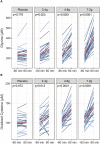A Randomized Controlled Clinical Trial in Healthy Older Adults to Determine Efficacy of Glycine and N-Acetylcysteine Supplementation on Glutathione Redox Status and Oxidative Damage
- PMID: 35821844
- PMCID: PMC9261343
- DOI: 10.3389/fragi.2022.852569
A Randomized Controlled Clinical Trial in Healthy Older Adults to Determine Efficacy of Glycine and N-Acetylcysteine Supplementation on Glutathione Redox Status and Oxidative Damage
Abstract
Glycine and cysteine are non-essential amino acids that are required to generate glutathione, an intracellular tripeptide that neutralizes reactive oxygen species and prevents tissue damage. During aging glutathione demand is thought to increase, but whether additional dietary intake of glycine and cysteine contributes towards the generation of glutathione in healthy older adults is not well understood. We investigated supplementation with glycine and n-acetylcysteine (GlyNAC) at three different daily doses for 2 weeks (low dose: 2.4 g, medium dose: 4.8 g, or high dose: 7.2 g/day, 1:1 ratio) in a randomized, controlled clinical trial in 114 healthy volunteers. Despite representing a cohort of healthy older adults (age mean = 65 years), we found significantly higher baseline levels of markers of oxidative stress, including that of malondialdehyde (MDA, 0.158 vs. 0.136 µmol/L, p < 0.0001), total cysteine (Cysteine-T, 314.8 vs. 276 µM, p < 0.0001), oxidized glutathione (GSSG, 174.5 vs. 132.3 µmol/L, p < 0.0001), and a lower ratio of reduced to oxidized glutathione (GSH-F:GSSG) (11.78 vs. 15.26, p = 0.0018) compared to a young reference group (age mean = 31.7 years, n = 20). GlyNAC supplementation was safe and well tolerated by the subjects, but did not increase levels of GSH-F:GSSG (end of study, placebo = 12.49 vs. 7.2 g = 12.65, p-value = 0.739) or that of total glutathione (GSH-T) (end of study, placebo = 903.5 vs. 7.2 g = 959.6 mg/L, p-value = 0.278), the primary endpoint of the study. Post-hoc analyses revealed that a subset of subjects characterized by high oxidative stress (above the median for MDA) and low baseline GSH-T status (below the median), who received the medium and high doses of GlyNAC, presented increased glutathione generation (end of study, placebo = 819.7 vs. 4.8g/7.2 g = 905.4 mg/L, p-value = 0.016). In summary GlyNAC supplementation is safe, well tolerated, and may increase glutathione levels in older adults with high glutathione demand. Clinical Trial Registration: https://clinicaltrials.gov/ct2/show/NCT05041179, NCT05041179.
Keywords: cardiometabolic diseases; glutathione; glycine; healthy aging; n-acetylcysteine; nutrition; oxidative stress; total cysteine.
Copyright © 2022 Lizzo, Migliavacca, Lamers, Frézal, Corthesy, Vinyes-Parès, Bosco, Karagounis, Hövelmann, Heise, von Eynatten and Gut.
Conflict of interest statement
GL, EM, AF, JC, NB, and PG are employees of Nestlé Institute of Health Sciences, Nestlé Research, Societé des Produits de Nestlé. GV-P, LK, and ME are employees of Nestlé Health Sciences, a subsidiary of Nestlé. Nestlé Health Sciences holds patents and licenses to patents and markets products for the use of glycine and n-acetylcysteine in conditions related to impaired mitochondrial functions. DL and UH are employees and TH is an employee and shareholder of Profil Institute for Metabolic Research GmbH, which has received research funding from Nestlé Health Sciences.
Figures





Similar articles
-
Supplementing Glycine and N-Acetylcysteine (GlyNAC) in Older Adults Improves Glutathione Deficiency, Oxidative Stress, Mitochondrial Dysfunction, Inflammation, Physical Function, and Aging Hallmarks: A Randomized Clinical Trial.J Gerontol A Biol Sci Med Sci. 2023 Jan 26;78(1):75-89. doi: 10.1093/gerona/glac135. J Gerontol A Biol Sci Med Sci. 2023. PMID: 35975308 Free PMC article. Clinical Trial.
-
Glycine and N-acetylcysteine (GlyNAC) supplementation in older adults improves glutathione deficiency, oxidative stress, mitochondrial dysfunction, inflammation, insulin resistance, endothelial dysfunction, genotoxicity, muscle strength, and cognition: Results of a pilot clinical trial.Clin Transl Med. 2021 Mar;11(3):e372. doi: 10.1002/ctm2.372. Clin Transl Med. 2021. PMID: 33783984 Free PMC article.
-
GlyNAC Supplementation Improves Glutathione Deficiency, Oxidative Stress, Mitochondrial Dysfunction, Inflammation, Aging Hallmarks, Metabolic Defects, Muscle Strength, Cognitive Decline, and Body Composition: Implications for Healthy Aging.J Nutr. 2021 Dec 3;151(12):3606-3616. doi: 10.1093/jn/nxab309. J Nutr. 2021. PMID: 34587244 Review.
-
GlyNAC (Glycine and N-Acetylcysteine) Supplementation in Mice Increases Length of Life by Correcting Glutathione Deficiency, Oxidative Stress, Mitochondrial Dysfunction, Abnormalities in Mitophagy and Nutrient Sensing, and Genomic Damage.Nutrients. 2022 Mar 7;14(5):1114. doi: 10.3390/nu14051114. Nutrients. 2022. PMID: 35268089 Free PMC article.
-
An increased need for dietary cysteine in support of glutathione synthesis may underlie the increased risk for mortality associated with low protein intake in the elderly.Age (Dordr). 2015 Oct;37(5):96. doi: 10.1007/s11357-015-9823-8. Epub 2015 Sep 11. Age (Dordr). 2015. PMID: 26362762 Free PMC article. Review.
Cited by
-
Assessment of Vitamin E and Glutathione Peroxidase Levels in Salivary Samples of Children With and Without Dental Caries in Erbil City, Iraq.Cureus. 2024 Nov 30;16(11):e74872. doi: 10.7759/cureus.74872. eCollection 2024 Nov. Cureus. 2024. PMID: 39741611 Free PMC article.
-
Mitochondria as Nutritional Targets to Maintain Muscle Health and Physical Function During Ageing.Sports Med. 2024 Sep;54(9):2291-2309. doi: 10.1007/s40279-024-02072-7. Epub 2024 Jul 26. Sports Med. 2024. PMID: 39060742 Free PMC article. Review.
-
Vascular senescence and aging: mechanisms, clinical implications, and therapeutic prospects.Biogerontology. 2025 May 26;26(3):118. doi: 10.1007/s10522-025-10256-5. Biogerontology. 2025. PMID: 40418230 Free PMC article. Review.
-
Circulating and Urinary Concentrations of Malondialdehyde in Aging Humans in Health and Disease: Review and Discussion.Biomedicines. 2023 Oct 10;11(10):2744. doi: 10.3390/biomedicines11102744. Biomedicines. 2023. PMID: 37893117 Free PMC article. Review.
-
Aging mitochondria in the context of SARS-CoV-2: exploring interactions and implications.Front Aging. 2024 Sep 24;5:1442323. doi: 10.3389/fragi.2024.1442323. eCollection 2024. Front Aging. 2024. PMID: 39380657 Free PMC article. Review.
References
-
- Cruz M., Maldonado-Bernal C., Mondragón-Gonzalez R., Sanchez-Barrera R., Wacher N. H., Carvajal-Sandoval G., et al. (2008). Glycine Treatment Decreases Proinflammatory Cytokines and Increases Interferon-γ in Patients with Type 2 Diabetes. J. Endocrinol. Invest. 31, 694–699. 10.1007/bf03346417 - DOI - PubMed
Associated data
LinkOut - more resources
Full Text Sources
Medical

